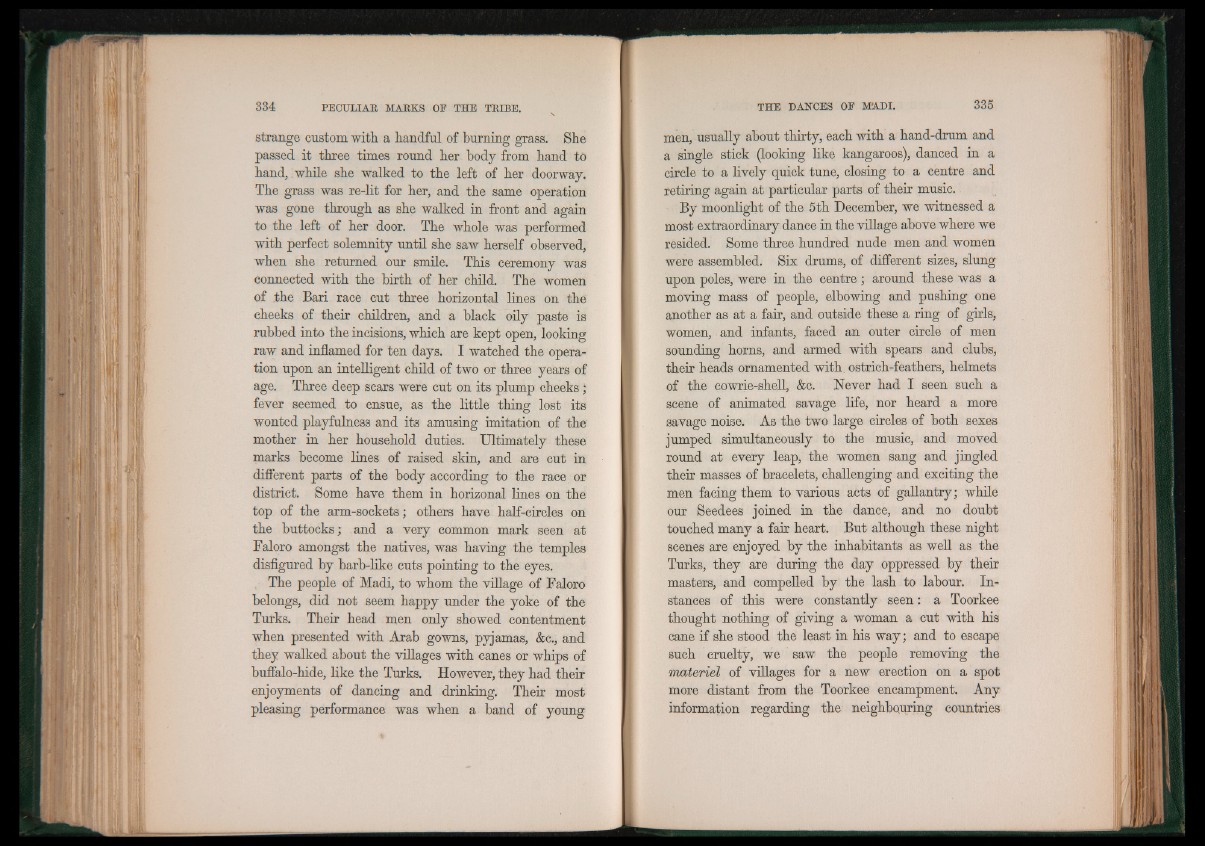
strange custom with a handful of burning grass. She
passed it three times round her body from hand to
hand, while she walked to the left of her doorway.
The grass was re-lit for her, and the same operation
was gone through as she walked in front and again
to the left of her door. The whole was performed
with perfect solemnity until she saw herself observed,
when she returned our smile. This ceremony was
connected with the birth of her child. The women
of the Bari race cut three horizontal lines on the
cheeks of their children, and a black oily paste is
rubbed into the incisions, which are kept open, looking
raw and inflamed for ten days. I watched the operation
upon an intelligent child of two or three years of
age. Three deep scars were cut on its plump cheeks;
fever seemed to ensue, as the little thing lost its
wonted playfulness and its amusing imitation of the
mother in her household duties. Ultimately these
marks become lines of raised skin, and are cut in
different parts of the body according to the race or
district. Borne have them in horizonal lines on the
top of the arm-sockets; others have half-circles on
the buttocks; and a very common mark seen at
Faloro amongst the natives, was having the temples
disfigured by barb-like cuts pointing to the eyes.
The people of Madi, to whom the village of Faloro
belongs, did not seem happy under the yoke of the
Turks. Their head men only showed contentment
when presented with Arab gowns, pyjamas, &c., and
they walked about the villages with canes or whips of
buffalo-hide, like the Turks. However, they had their
enjoyments of dancing and drinking. Their most
pleasing performance was when a band of young
men, usually about thirty, each with a hand-drum and
a single stick (looking like kangaroos), danced in a
circle to a lively quick tune, closing to a centre and
retiring again at particular parts of their music.
By moonlight of the 5th December, we witnessed a
most extraordinary dance in the village above where we
resided. Some three hundred nude men and women
were assembled. Six drums, of different sizes, slung
upon poles, were in the centre; around these was a
moving mass of people, elbowing and pushing one
another as at a fair, and outside these a ring of girls,
women, and infants, faced an outer circle of men
sounding horns, and armed with spears and clubs,
their heads ornamented with ostrich-feathers, helmets
of the cowrie-shell, &c. Never had I seen such a
scene of animated savage life, nor heard a more
savage noise. As the two large circles of both sexes
jumped simultaneously to the music, and moved
round at every leap, the women sang and jingled
their masses of bracelets, challenging and exciting the
men facing them to various acts of gallantry; while
our Seedees joined in the dance, and no doubt
touched many a fair heart. But although these night
scenes are enjoyed by the inhabitants as well as the
Turks, they are during the day oppressed by their
masters, and compelled by the lash to labour. Instances
of this were constantly seen: a Toorkee
thought nothing of giving a woman a cut with his
cane if she stood the least in his way; and to escape
such cruelty, we saw the people removing the
materiel of villages for a new erection on a spot
more distant from the Toorkee encampment. Any
information regarding the neighbQuring countries